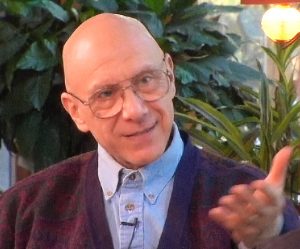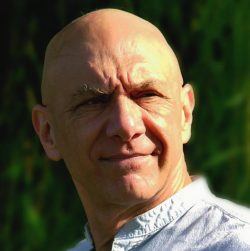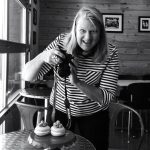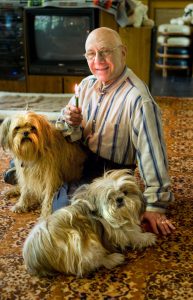
As physicians, we are not taught how to communicate with patients. And, because of a fear of being sued, we too frequently tell people all of the adverse side effects of therapy and never mention the benefits. Every time I hear a TV commercial mentioning how the respective drug being advertised could “kill” the recipient, I wonder why anyone would try it.
Over the years, I’ve begun to realize the importance of how a patient’s beliefs are formed and how they stem from both my experiences and their experiences, and not necessarily their diagnosis. In a sense it is best summed up by the legendary psychiatrist, Dr. Milton Erickson, who wrote some notes in a patient’s chart and then stepped out of the office for a minute. He anticipated that the patient would peak at the chart. She saw the words, “Doing well.” How therapeutic.
If you aren’t familiar with his story, Erickson was stricken with polio as a child. One evening he overheard his doctor tell his mother he would likely die by the morning. The doctor’s words angered him and in spite of his doctor’s foreboding prediction, he survived the night. Erickson turned his own experiences of hearing negative messages from his doctors into a new paradigm of healing. He became a psychiatrist and dedicated his life to the art and science of self-healing and the mind-body connection.
Shifting Our Conversations Toward Hope and Humor
One way we can do this in our daily practice is to ask patients to describe what they are experiencing. When we shift the conversation away from a medically technical diagnosis and toward experiences, both patient and provider can reach a common language. If they are negative words, ask which words fit into the how and why of their current situation.
The words they share – such as pressure describing pain or a cancer treatment – allows the practitioner to help the patient eliminate destructive thoughts and outside influences that make them feel like a failure. I frequently help my patients turn their words around. For instance, one of my patients had no side effects to radiation and the radiation therapist thought his machine was malfunctioning until he saw my name in her chart. “This is one of Siegel’s crazy patients,” he thought. When he asked, why she had no side effects? She said, “I get out of the way and let it go to my tumor.” I couldn’t have said it better.
Paradox and humor is another way to readjust thoughts and feelings and cut through the fear. For example, a woman I was about to operate on was in total panic. I spent a very long time trying to calm her down, but nothing made a difference. So, I stopped trying and wheeled her into the operating room. In all her fear, she managed a weak prayer, “Thank God all these wonderful people will be taking care of me.” I knew agreeing with her wouldn’t accomplish anything, so I said:
I know these people. I have worked with them for years. They are not wonderful people. For a second, she looked bewildered but then burst out laughing as did everyone in the operating room. In that split second, we all became family. Fear cannot exist in the presence of love and laughter.”
I was the police surgeon in New Haven, Connecticut for many years. One day a policeman I knew called my office. “Doctor Siegel I am going to commit suicide,” he said as I picked up the phone.
I answered, “Jimmy if you commit suicide I will never talk to you again.” He hung up the phone and 15 minutes later was in my office. He was mad as hell and shouting that he had been holding a gun in his mouth and how could I be so insensitive and uncaring.
“Jimmy did you notice you’re not dead,” I said. He laughed and realized what I said worked. We became buddies after that. Fear cannot exist in the presence of love and laughter.
One day prior to performing minor surgery in my office, a patient and I got into an intense and interesting discussion. I picked up the scalpel while we were talking and made an incision. My nurse was frantically waving at me and pointing at the unused syringe containing the local anesthetic. I calmly asked the patient, “How are you feeling?” “Fine,” he answered. So, I completed the surgery. Afterward, I told him we were both hypnotized and that I had not used any local anesthetic to numb the area of surgery. Since then, I have used hypnotherapy in the operating room in a less dramatic fashion, but with equal success.
While these examples may seem somewhat extreme, there are many other ways to adopt these practices into your daily work. As l learned more about the power of words, I paid more attention to what was said in the operating room. Here are a few examples:
- A simple thing, like changing my words about an injection or IV from feeling like a bee sting to a mosquito bite can make a dramatic difference.
- Or, when an anesthesiologist talks to a patient about their going out, I might ask the patient, “When was the last time you went out on a date.” This leaves the patient with a good feeling as the anesthesia begins to take effect.
- Decades ago I added music in the O.R. theater despite early concerns that it was an explosion hazard. Once the staff fears were resolved, everyone felt noticeably more positive during the surgery and I noticed more positive patient outcomes. Today, we have studies verify the benefits of music such as, shortening the time of the surgery, fewer drug requirements and patients experiencing less recovery pain.
- Before patients awake from surgery I say, “You will wake up comfortable, thirsty and hungry.” I eventually added, “but you won’t finish what is on your plate,” so as to counter overeating and post-surgery discomfort.
- During surgery, I also ask my patients not to bleed to divert the blood away from the area of surgery.
I recognize such ideas are not traditional norms for surgeons, for those who work with me, it’s hard to ignore success. Often times these ideas were adopted into hospital policy, which I was happy to see. The only request that I couldn’t get the administrators to give their OK to was guided imagery on patients in room televisions to prepare them for surgery.
From the Mouths of Babes, What We Can Learn from Children
What really opened my mind to the power of words was my experience as a pediatric surgeon. To reassure children that they would not be in pain while they were undergoing surgery, I told them while in the emergency room, “You will go to sleep when you go into the operating room.”
I was shocked to see children fall asleep while they were being wheeled on the stretcher. One boy flipped over and went to sleep as we entered the O.R. When I turned him over for his appendectomy he awakened and said, “You told me I would go to sleep, and I sleep on my stomach.” We reached a compromise.
Children hate having blood drawn, so we changed our words during this often stressful but necessary process. Prior to drawing blood, we told them the alcohol swab would numb their skin. In general, one third had no pain at all and most had a less traumatic experience. For the few who told me it didn’t work, we apologized and blamed it on a defective alcohol sponge.
Another often used method was labeling vitamin pills as anti-nausea or hair growing pills – but only with parent’s cooperation. In general, we frequently saw reduced side effects of chemotherapy and other treatments because of the faith they had in their care providers.
Now imagine using this same idea for adults. For instance, imagine a patient is on her way home from chemotherapy. In anticipation of vomiting, you give her husband throw up bags for the car ride home. Now imagine that one of those bags is filled with fresh roses. Just by changing the bag’s associated use, the patient is less likely to feel nauseated in the car. These small gestures of love can make a big impact on the patient’s sense of wellness. As one woman said,
I opened the bag and there were a dozen roses from my husband in it. I never vomited again.”
The Power of Believing
The mind and faith are powerful tools for both care providers and patients. I’ve seen examples of people who thought they were receiving chemotherapy. In truth, they were not due to an error in preparing the medication or the machine had not been properly reset after a repair process. One radiation therapy doctor said to me he had mistakenly not treated anyone for a month and discovered the problem during the radiation therapy machine’s monthly inspection.
Of course he felt terrible and repeated over and again how sorry he was for the mistake. “You’d have to be an idiot to not know you weren’t treating anyone,” I said. “You obviously witnessed people experiencing side effects and tumor shrinkage – without radiation exposure.” His eyes bulged and he said, “Oh my God you’re right.” Mind and faith are powerful tools.
I’ll close with one of favorites. The cousin of my father-in-law’s nurse’s aide was told she was terminal with leukemia and that chemotherapy was a waste of time. When the aide heard this, she suggested that the patient be in my care. “Doctor Siegel makes people well all the time,” she said. After the patient’s hospital admission, I told her that I could not treat her but that I could recommend an oncologist and we parted with a hug.
In private, my oncologist friend told me he agreed with her original doctor’s diagnosis that she was terminal, but he would treat her and give her hope. His letters to me reflected hope and thus began with words like, “doing well,” and after many months of treatment they ended with, “in complete remission.” She eventually went home to drive her own doctor nuts. Later she told her cousin: “When Doctor Siegel hugged me I knew I would get well.”
She is not alone. I know patients who left their troubles to God and had their cancer disappear. That is called self-induced healing and not spontaneous remission. There is so much we can learn from exceptional patients about survival behavior. Ask them why they didn’t die, rather than saying what doctors tend to say, “You are doing very well. Whatever you’re doing keep it up.” This safe response means the doctor learns nothing from their patients. Personality characteristics and survival are inseparable.
There is much we can learn from these patients about survival behavior. Rather than sounding like one of those awful television drug ads, it is one of our jobs to remind patients of their potential. Our Creator has built survival mechanisms into all living things that can heal wounds, alter our genes and overcome various diseases. As Ernest Holmes said, “What if Jesus was the only normal person who ever lived?” If we help our patients love their life and love their body, instead of being fearful and betrayed, amazing things can happen. We simply need to show up for practice, have faith and not fear failing.







